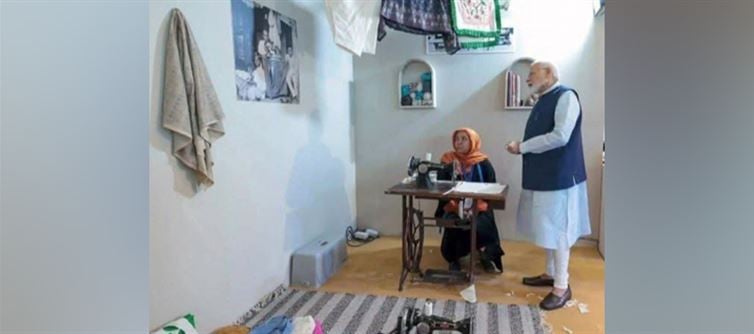
🧨When Poverty Becomes a Prop
There was a time when leaders visited homes of the poor to understand their struggles.
Now, they visit sets designed to look like poverty — complete with plastic paint, fresh props, and LED lighting — all for the perfect photo op.
Prime minister Narendra Modi’s latest photoshoot, shared with the caption “India’s artisanal diversity on display at Yashobhoomi!”, features him sitting inside what is being touted as a humble rural hut.
But a closer look turns the “humility” into high-budget theatre: a freshly painted hut, spotless interiors, new furnishings, and a resident who’s somehow wearing an ID card at home — because in Modi’s India, even poverty has to look photo-ready.
🎭 FAKE YAMUNA, FAKE CLASSROOM, FAKE HUT — SAME SCRIPT
First came the “clean Yamuna” spectacle — a man-made filtered pond dressed up as the sacred river for Modi’s Chhath Puja dip.
Then came the “classroom” visit, where everything from the desks to the students’ smiles looked borrowed from a film set.
Now, the saga continues with the “Modi in a hut” narrative — except the hut has plastic paint, a brand-new sewing machine, and an expensive carpet.
Every “ordinary” scene looks like it was written by a PR intern and produced by a set designer.
💡 A STUDIO DISGUISED AS SIMPLICITY
Look closely at the photos:
The walls gleam with a fresh coat of plastic paint.
The floor boasts a new carpet.
A high-mast light outside ensures perfect visibility.
Even the pillow covers are freshly ironed.
And yes — the “villager” proudly sports an ID card, as though poverty requires government accreditation.
What should have been a spontaneous interaction now feels like a government-sponsored ad shoot — where every object, angle, and gesture is curated to craft the illusion of connection.
🩴 SHOES IN A HUT, SYMPTOM OF A LARGER ARROGANCE
The image of Modi entering the hut wearing shoes may seem trivial — but it tells a story.
In rural India, stepping inside a home with shoes is unthinkable; it’s disrespectful.
Yet, for the camera, cultural sensibility gives way to symbolism. The leader must remain spotless, even if the story is built on someone else’s floor mat.
🪞 THE CURATED HUMILITY INDUSTRY
Modi’s photo-ops have become a genre unto themselves — “curated humility.”
From sitting on a mat with hand-crafted artifacts to pretending to inspect local produce, each photo is framed to project accessibility while maintaining distance.
The poor aren’t being empowered — they’re being aestheticized. Their struggles are backdrops for political storytelling.
This is not leadership; it’s lifestyle branding — with poverty as the aesthetic and power as the product.
💰 LIGHTS, CAMERA, PROPAGANDA
Every photo carries the subtle stamp of PR machinery gone wild.
The hut is not a home — it’s a set.
The woman isn’t a citizen — she’s a symbol.
The sewing machine isn’t a livelihood tool — it’s a talking point.
Behind every “spontaneous” shot is a storyboard, a director, and a strategy meeting deciding which side of “poverty” looks best on camera.
🧠 WHEN AUTHENTICITY DIES, ALL THAT’S LEFT IS A FILTER
This obsession with optics replaces reality with performance.
You don’t have to fix the Yamuna — just build a pond.
You don’t have to visit a struggling family — just construct a hut with fresh paint.
You don’t have to empower the artisan — just sit beside them for 10 minutes and post a caption about “India’s artisanal diversity.”
It’s the Instagram-ification of governance — where empathy is measured in engagement metrics and poverty is framed in portrait mode.
🧨 FINAL WORD: THEATRICS OVER TRUTH
Modi’s “hut” photoshoot isn’t about artisans, tradition, or humility — it’s about image management in 4K resolution.
Real artisans work without electricity. Real huts don’t have polished walls and stage lights. Real empathy doesn’t need a camera crew.
The prime minister’s PR empire might win hearts on social media, but history will remember these moments for what they are — a cinematic performance of empathy, built on the ruins of authenticity.
India doesn’t need another fake hut.
It needs leaders who can step out of the studio — and into reality.




 click and follow Indiaherald WhatsApp channel
click and follow Indiaherald WhatsApp channel